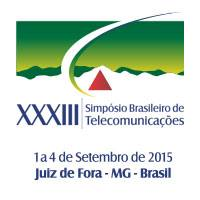
XXXIII Simpósio Brasileiro de Telecomunicações

Robust TDOA-Based Sound Source Localization
Felipe Barboza da Silva, Wallace Alves Martins
DOI: 10.14209/sbrt.2015.148
Keywords: Sound source localization time-difference of ar- rival generalized cross-correlation reverberation
Abstract
This paper proposes a new technique for solving sound source localization problems using time-difference of arrival (TDOA). The key aspect of the proposal relies on both the use of a median-based cost function, which allows for outlier filtering of misestimated TDOAs, and a TDOA discarding process. Simulation results indicate that the proposed method achieves centimeter-level localization accuracy even when dealing with high reverberation and low signal-to-noise ratio (SNR). Indeed, for an SNR of 10 dB and a 5.2 m × 7.5 m × 2.6 m room with reverberation time of 800 ms, our method achieves median errors under 10 cm and mean errors about 20 cm, outperforming closed-form least-squares solutions and classic maximum likelihood-based TDOA techniques.Download

On the Interoperability of Bufferbloat Solutions
Thiago Cardozo, Alex Borges Vieira, Artur Ziviani, Ana Paula Couto da Silva
DOI: 10.14209/sbrt.2015.149
Keywords: Bufferbloat AQM CoDel BQL FQ-CoDel PIE
Abstract
Bufferbloat phenomenon is related to the excessive packet queuing in over-sized buffers inside the network that may lead to network performance degradation. In this context, we observe a lack of experimental results considering the practi- cal aspects of off-the-shelf network devices. In this paper, we present a systematic analysis of the bufferbloat phenomenon considering the microscopic view of the buffer architecture of typical network devices. Moreover, we evaluate the most common fighting bufferbloat solutions recently proposed in the literature, such as BQL, CoDel, FQ-CoDel, and PIE. In fact, we have only observed bufferbloat effects under particular configurations. Second, all approaches we have tested are efficient against bufferbloat, although presenting different performances. Finally, mechanism we have evaluated can interoperate. We only notice a bad performance under a misconfigured BQL; actually results suggest a misconfigured BQL is worse than no BQL at all.Download
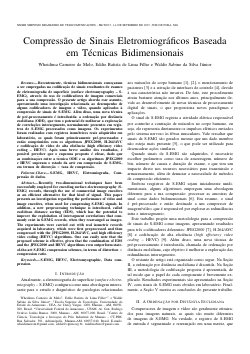
Compressão de Sinais Eletromiográficos Baseada em Técnicas Bidimensionais
Wheidima Carneiro de Melo, Eddie Batista de Lima Filho, Waldir Sabino da Silva Júnior
DOI: 10.14209/sbrt.2015.154
Keywords: S-EMG HEVC Electromyographic Data com- pression.
Abstract
Recently, two-dimensional techniques have been successfully employed for encoding surface-electromyography (S- EMG) records, through the use of commercial image encoders as an efficient alternative for that kind of signal. This paper presents an investigation regarding the performance of video and image encoders, when used for compressing S-EMG signals. In addition, a new preprocessing technique is introduced, called euclidean distance sorting (EDS), which has the potential to improve the exploitation of intersegment correlations that com- monly exist in S-EMG records, when they rearranged as images. The experiments were carried out with real isometric records acquired in laboratory, which were first preprocessed and then compressed with the JPEG2000, H.264/AVC, and high efficiency video coding (HEVC) algorithms. One can easily note that the proposed scheme is effective, given that the combination of EDS and the JPEG2000 and HEVC algorithms even outperform state- of-the-art S-EMG compression schemes, in terms of distortion × compression ratio.Download

Sensoriamento Espectral Cognitivo Baseado em Testes Estatísticos em Canais Sujeitos ao Desvanecimento Nakagami−m
Fabrício B. S. Carvalho, Waslon T. A. Lopes, Marcelo S. Alencar
DOI: 10.14209/sbrt.2015.153
Keywords: Spectrum Sensing Cognitive Radio Statistical Tests Nakagami-m Fading
Abstract
Spectrum sensing is an important tool for the expansion of cognitive radio. This paper evaluates the use of statistic tests to optimize the spectral detection of available frequency bands for opportunistic occupation. Statistical cha- racteristics of the transmitted signals over a channel subject to Nakagami-m fading are selected to achieve better cognitive sensing performance. More precisely, Jarque-Bera, Kurtosis and Skewness statistic tests are compared via simulation in terms of its detection probabilities in non-fading and over Nakagami- m fading channels. Simulation results indicate that these statistic tests can be effectively applied to cognitive wireless channels that are subjected to fading.Download
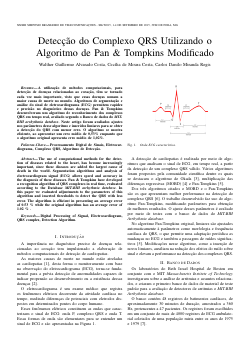
Detecção do Complexo QRS Utilizando o Algoritmo de Pan & Tompkins Modificado
Walther Guillermo Alvarado Costa, Cecília de Moura Costa, Carlos Danilo Miranda Regis
DOI: 10.14209/sbrt.2015.155
Keywords: Digital Processing of Signal Electrocardiogram QRS complex Detection Algorithm.
Abstract
The use of computational methods for the detec- tion of diseases related to the heart, has become increasingly important, since these diseases are added the largest cause of death in the world. Segmentation algorithms and analysis of electrocardiogram signal (ECG) allows speed and accuracy in the diagnosis of these diseases. Pan & Tompkins have developed a recognition algorithm of QRS complexes in real time, evaluated according to the Database MIT-BIH arrhythmia database. In this paper we evaluated adjustments to the parameters of this algorithm and inserted thresholds to detect the QRS with less error. The algorithm is efficient in presenting an average error of 0.53 % while the original algorithm has an average error of 1.02 %Download
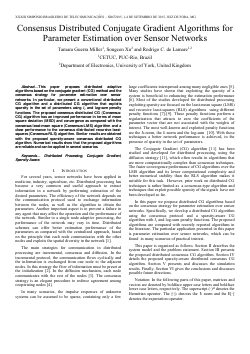
Consensus Distributed Conjugate Gradient Algorithms for Parameter Estimation over Sensor Networks
Tamara Guerra Miller, Songcen Xu, Rodrigo C. de Lamare
DOI: 10.14209/sbrt.2015.163
Keywords: Distributed Processing Conjugate Gradient SparsityAware
Abstract
This paper proposes distributed adaptive algorithmsbased on the conjugate gradient (CG) method and the consensus strategy for parameter estimation over sensor networks. In particular, we present a conventional distributed CG algorithm and a distributed CG algorithm that exploits sparsity in the set of parameters using l1 and log-sum penalty functions. The proposed consensus distributed CG (Consensus- CG) algorithm has an improved performance in terms of mean square deviation (MSD) and convergence as compared with the consensus least-mean square (Consensus-LMS) algorithm and a close performance to the consensus distributed recursive least- squares (Consensus-RLS) algorithm. Similar results are obtained with the proposed sparsity-aware consensus distributed CG algorithm. Numerical results show that the proposed algorithms are reliable and can be applied in several scenarios.Download

Acessibilidade no setor varejista utilizando RFID e Beacons
Paula Mayara Silva de Albuquerque, Levi Moreira de Albuquerque, Sheyla Rodrigues Rabelo, João Paulo Soares de Sousa, Pedro Klécius Farias Cardoso, Dr.
DOI: 10.14209/sbrt.2015.164
Keywords: Accessible Tags Electronic Tag RFID Mobile Technology Beacons
Abstract
The electronic tags have increasingly been used to store product information, allowing automatic identification, product tracking, stock control and much more applications. Putting together RFID clothes tags and the Beacon technology (used to locate a client using a Smartphone) it is possible to improve client access to product information in a department store, mainly if the client has a visual disability. In this context, the following project proposes a system which incorporates RFID tags and the Beacon technology altogether with a Smartphone app as a way to promote accessibility in department stores. That way, the client visually impaired can make use of a Smartphone with this app to receive indications of where a certain item can be found in the store alongside with the RFID tags data which will be sonorously dictated to the client.Download
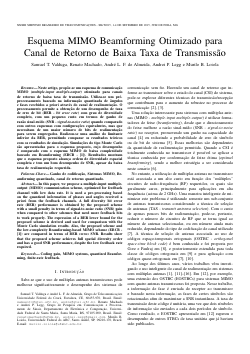
Esquema MIMO Beamforming Otimizado para Canal de Retorno de Baixa Taxa de Transmissão
Samuel T. Valduga, Renato Machado, Andre L. F. de Almeida, Andrei P. Legg, Murilo B. Loiola
DOI: 10.14209/sbrt.2015.165
Keywords: Coding gain MIMO systems quantized Beamfor- ming finite-rate feedback
Abstract
In this paper, we propose a multiple-input multiple- output (MIMO) communication scheme, optimized for feedback channel with low data rate. It is used a pre-processing based on the quantized information of phases and angles received a priori from the feedback channels. A full diversity bit error rate (BER) performance is obtained by the proposed scheme with a small penalty in terms of signal-to-noise ratio (SNR) gain when compared to other schemes that need more feedback bits to work properly. The expression of a BER lower bound for the proposed scheme is derived and used for comparison with the Monte Carlo simulation results. Also, the proposed scheme and the low-complexity Beamforming-based MIMO scheme (EBCB - [1]) are compared in terms of BER versus SNR. Results show that the proposed scheme achieves full spatial diversity order and has a good SNR performance, despite the low feedback rate required.Download

Uma Técnica para Ocultação de Partituras Musicais em Sinais de Áudio
Mario C. L. da Cruz Jr., Juliano B. Lima
DOI: 10.14209/sbrt.2015.166
Keywords: Data hiding discrete Fourier transform music scores
Abstract
n this paper, a technique for hiding musical scores in digital audio signals is described. The purpose is to provide for a user accessing the audio file of a music the respective musical score, which can be extracted by means of a systematic processing. The method employs musical scores written according to the ABC notation, which encodes the musical symbols in text format. The characters are converted into bits and embedded in the audio signal using a phase adjustment procedure in the discrete Fourier transform domain. Experiments which allow to evaluate the robustness of the method against mp3 compression are carried out and strategies for enhancing its performance are discussed.Download
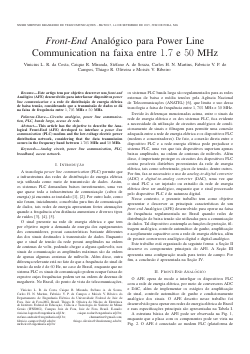
Front-End Analógico para Power Line Communication na faixa entre 1.7 e 50 MHz
Vinicius L. R. da Costa, Caique R. Miranda, St´efano A. de Souza, Carlos H. N. Martins, Fabricio V. P. de Campos, Thiago R. Oliveira, Moisés V. Ribeiro
DOI: 10.14209/sbrt.2015.167
Keywords: Analog circuit power line communication PLC broadband access network
Abstract
This article has the objective to describe the Ana- logical Front-End (AFE) developed to interface a power line communication (PLC) modem and the low-voltage electric power distribution network, considering that the data transmission occurs in the frequency band between 1.705 MHz and 50 MHz.Download